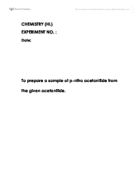Total percentage of random uncertainty:
The Rf values of the amino acid samples may not be completely accurate as all of them did not match the given literature value. This may be due to random uncertainties. The ruler had an uncertainty of ±0.1cm. The values that are used in the calculation for this number are shown below:
Conclusion
This paper chromatography experiment was to determine the identity of three amino acids within a given sample. Paper chromatography involves two stages: a stationary phase and a mobile phase. The stationary phase is the water trapped within the cellulose in the paper and the mobile phase is the butan-1-ol, ethanoic acid and water solvent soaking up the paper through capillary action. The separation of the mixture of amino acids relies on the partition of the components between the water in the chromatography paper and the solvent moving over the paper.
In this experiment, the purplish colour spots on the chromatogram indicate the presence of amino acids within the mixture. The Rf value of the three unknown spots can then be calculated after measuring the distance migrated by the amino acid samples and the solvent front. The values of the three unknown samples are then compared to the literature values provided. Unknown sample 1 had a very close Rf value of 0.16 to lysine, which was 0.14. Unknown sample 2 had a value of 0.26, which was closest to the amino acid, aspartic acid. Finally, unknown sample three had the highest Rf value of 0.74, which was closest to leucine (0.73). This indicates that unknown sample 1 is lysine, unknown sample 2 is aspartic acid and unknown sample 3 is leucine. The distance travelled by the amino acids shows how much the amino acid is attracted to the chromatography paper. Lysine travelled the least, which means that this sample was very attracted to the paper and not as much to the solvent as it did not move up the paper, thus resulting in a low Rf value. On the other hand, leucine has the highest Rf value which means that leucine was more attracted to the solvent than the paper thus moved higher up the chromatography paper.
However, the literature values of the amino acids differ from the Rf values I have obtained from the experiment. To calculate the validity of my results, I will be comparing the literature values against the experimental values I have obtained for all three amino acid samples.
Percentage difference = (experimental value – literature value)
literature value x 100
For lysine, the percentage difference of 14.2 is too large for my Rf value. This is because the total percentage of random uncertainties only accounts for 6.25%, meaning that the other 7.95% difference is due to systematic errors. For aspartic acid, there are a 4.33% of systemic errors. For leucine, the systemic error was lower than the error from random uncertainties. Random uncertainties for leucine accounts for 1.43% of the total percentage difference of 1.37%. This concludes that the results obtained from this experiment were not accurate enough as the literature value was not exactly the same as the value obtained.
Evaluation








